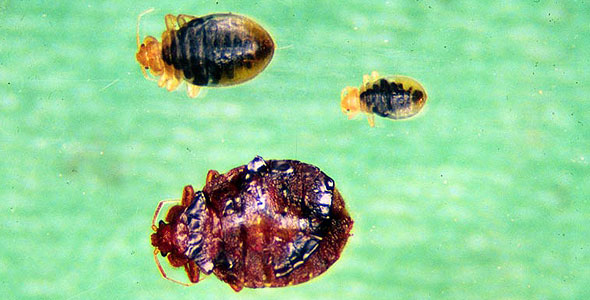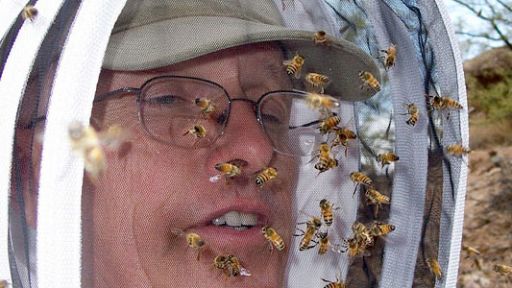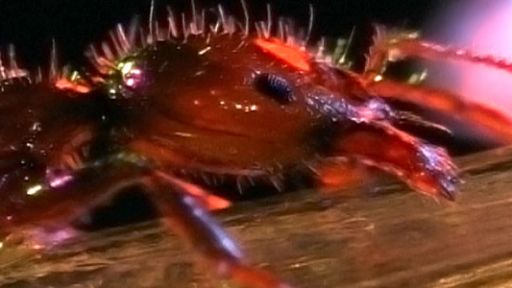Nightlife in New York has recently become a lot more irritating. And it’s all due to a scoundrel whose bedside manner is enough to make your skin crawl.
The bedbug is a tiny blood-sucking creature currently at the center of a huge worldwide crisis. Having infested cities across the globe, legions of them are now taking a fierce bite out of the Big Apple.
As we come to learn in NATURE’s Animals Behaving Worse, the growth in international travel and commerce has enabled wild invaders to easily hitchhike across borders and seek new territories, further blurring the boundaries that divide human and animal habitats. The bedbug is one globe-trotter that exploits human environments to such an extent that, for the most part, it simply can’t live without us.
Bedbugs are tiny nocturnal parasites about the size of an apple seed that subsist exclusively on blood. They prefer that of humans but will feed on other warm-blooded animals if necessary. Experts believe that in prehistoric times, this ancient species fed on the blood of cave-dwelling humans, and when people traded up to huts and houses, bedbugs moved along with them. After World War II, effective insecticides made infestations rare in the United States and for the past 50 years, Americans have slept tight. But times have changed.
Entomologists have noticed a worldwide upsurge in bedbug infestations within the last five years, especially in metropolises like New York, where they’ve turned up in homes and hotels, hospitals and health clubs. No one knows exactly why bedbugs are making such a bold comeback, but one thing is for certain: they have become the most cosmopolitan of parasites.
Called the new scourge of America, bedbugs are falsely reputed to prefer unkempt conditions. They are in fact equal-opportunity pests, invading swank hotel rooms and tidy homes with the same fervor as flophouses. “These critters know no face,” says Josh Alpert, vice president of Global Paladin Pest Control, which serves four states in the Northeast. “Bedbugs would infest the White House if they had a chance.”
For Alpert, business has never been better. “My company receives at least six new bedbug calls per day,” he says. “And we are only one of 1,000 pest control companies in the area. I think the main reason the infestation is as bad as it is, is because people aren’t taking the problem seriously.”
New York City resident Caitlin Heller discovered firsthand just how serious a problem bedbugs can be. When a cluster of insect bites appeared on her arms and legs, a friend suggested the possibility of bedbugs. The mere notion seemed so absurd that Caitlin decided to quickly put the theory to rest by inspecting her mattress. “I lifted the mattress one night before going to sleep and saw five or six bedbugs just scooting around, chilling, enjoying the comfort of the wrinkles in my box spring.”
Her initial reaction was that of defeat. “I’d done some research on the Internet about bedbugs and had found nothing promising,” says Caitlin. “They were tiny, hard to find, hard to kill, and caused painful, itchy welts when they bit me. When I saw that they were living in MY bed, I felt resigned to a lifelong battle with bedbugs. It was depressing.”
Attracted to body heat and carbon dioxide, the bugs find their victim and launch their attack under the cover of darkness, while the host is asleep. As they feed, they inject saliva, which contains an anticoagulant that causes an allergic reaction in some people. Though most never see the tiny pests, they leave their calling card in the form of itchy red bumps on the skin.
“Often, I’d find two or three or four bites in a group, which is typical of bedbug bites,” Caitlin recounts. “The grouped bites would form huge three- and four-inch welts that covered my arms, torso, shoulders, and legs. The bites were so itchy and painful that I was unable to concentrate on anything other than trying not to scratch the welts.”
What ensued was a three-month all-out war on the insects. “My first instinct when I found the bedbugs was to throw away my mattress,” she confesses. “In the end, that was pointless because the bedbugs weren’t living in the box spring. They were in the bed frame, the cracks in the floor, the nightstands, and only infested the new mattress when it came.”
Alpert finds this to be a common reaction among his clients. “Most people think if they get rid of their mattress that the bedbugs are gone, but they are dead wrong,” he says. “They aren’t aware of how hard it actually is to get rid of these little critters.”
Fighting a bedbug infestation is a time-consuming and costly process. Personal belongings must be removed from the property to be thoroughly cleaned, and carpets and floors must be fastidiously vacuumed before the exterminator can even begin to work.
Caitlin was lucky that her landlord was proactive about getting rid of the insects and immediately called an exterminator. When the first two treatments didn’t work, he arranged for a third and then a fourth. As it turned out, nine apartments in Caitlin’s building were infested, making the situation far more difficult to control. “Sometimes it’s hard getting everyone in the building to allow exterminators in to do their job,” she says. “But if the whole building isn’t treated, the bedbugs will migrate back and forth between apartments forever.”
One of the reasons bedbugs are so tough to exterminate is that they are tremendously prolific breeders. A female may lay several hundred eggs during her one-year lifespan, depositing them in cracks and crevices where other adults hide during the day. When conditions are favorable, eggs hatch in about five days and the nymphs start feeding immediately. Bedbugs can, however, go for months without a meal; this often gives people the false impression that they have rid their homes of the pests, when in fact the bugs are still lurking.
Though bedbugs have never been shown to transmit disease, the psychological stress and insomnia they trigger certainly take their toll. “I wasn’t getting any sleep because I was afraid to go to bed,” says Caitlin. “When I did, I kept imagining bugs crawling all over my body, and I spent most of the night awake, staring at the ceiling. I was absolutely traumatized, and none of the research I was doing was helping with the emotional fallout I was dealing with.”
After three months of agony and at her wit’s end, she came across someone’s personal account of their battle with bedbugs. “I finally found the validation I was looking for,” she confesses. “Before long, I found another personal account, and through e-mail, we managed to support each other through the stresses we faced just from deciding to go to bed.”
Sharing her ordeal proved so therapeutic that Caitlin was motivated to create a Weblog and support group in an effort to help others. “I decided to start the ‘Bedbug Blog’ in order to give other people a place to vent about their own situations. I wanted it to be a place for information, advice, and emotional support.”
Though Caitlin’s apartment is now bedbug-free, the insects continue to plague a growing number of homes across the United States. As dozens of new people turn to her site every day, she has found purpose in her experience. “I think the blog has been a help to people. The simple act of telling their horror story and knowing that someone else out there understands is so valuable.”
And the notion that she’s providing even a little relief to others is helping Caitlin finally sleep a little better at night.









